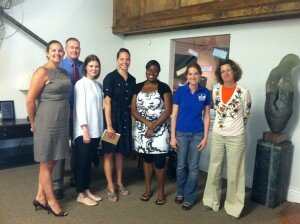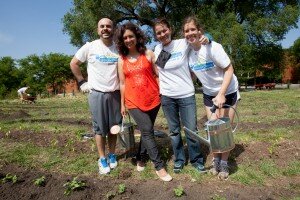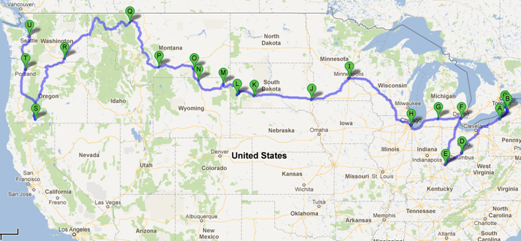Today’s post originally appeared on the Points of Light blog on July 18, 2012.
My family has continued our cross-country journey to discover people at the center of change. As we have made our way from Buffalo to Columbus and Cincinnati, we have found a few common themes – collaboration across sectors is the essential ingredient for community success, organizations are increasingly focused on the idea of collective impact, and citizens have a great reservoir of compassion and energy for meaningful engagement.
As we pulled into Columbus Wednesday evening, the arts district where we were staying was alive with people. This vitality was a preview of what we discovered in Columbus. This relatively small city is home to the country’s number one rated zoo, library and science center. (We also discovered the ice cream at Jeni’s Splendid Ice Cream. The experts may be right that Jeni’s has the #1 ice cream in the country. But we are determined to keep up the search!)
I met with Marsha Grigsby, the City Manager of nearby Dublin, Ohio and Christene Nardecchia who runs the volunteer program for Dublin. It was a fascinating lesson in the power of public/private partnerships and how government can engage citizens in a meaningful way. With a population of approximately 45,000, Dublin engages more than 3,000 volunteers in its programs, from running special events and festivals to serving as bike ambassadors to cleaning up the graveyard after a recent storm. They have discovered that citizen engagement can not only extend the service of government but also inform governing priorities and allow for real transparency with citizens and officials working side by side. Imagine if every city was effectively engaging citizens in identifying and meeting the critical priorities in this way?

The theme of public/private partnerships was further embodied in my visit with our affiliate, HandsOn Central Ohio. I was struck by the range of their programs – from running a 211 hotline that allows community members to give or get help, to administering a foster grandparent program with one hundred plus seniors giving tens of thousands of hours to marginalized children. One of the newest programs is a multi-sector partnership, administered by HandsOn, to create a centralized virtual reception center where homeless individuals are finding a path for placement into shelters.
Focused on improving access to dental care, the Dental OPTIONS program perfectly illustrates the benefits of cross-sector collaboration and the capacity of volunteers to leverage their unique skills. Funded in part through state-resources, HandsOn links patients with volunteer dentists who provide care for free or at reduced rates. Over the last 15 years, it has provided more than $4.5 million worth of dental care to individuals. Nearly 40% of the people in Ohio do not have health insurance and there are many that suffer enormous pain and serious health affects as a result of failure to receive expensive dental care.
 In Cincinnati, I had lunch with Jeff Edmondson, managing director of the Strive Network. I was taken by Jeff’s vision of the importance of a multi-sector approach – how his community of Cincinnati is finding that downtown development, education, and virtually every other advance is dependent upon cross-sector collaboration and civic leadership. Building the civic infrastructure to support the success of every child, every step of the way, from cradle to career is the vision of STRIVE - a Cincinnati-based nonprofit initiative that is bringing together all sectors of the community to ensure success for the community’s children. Strive has met with extraordinary success: a 9% rise in kindergarten readiness, an 11% increase in high school graduation and a 10% increase in college enrollment. They are not creating more programs, but re-aligning community resources around proven methods of effecting change. Their successes have given birth to the Strive Network which works with communities nationwide to create a civic infrastructure which unites stakeholders around shared goals, measures and results in education.
In Cincinnati, I had lunch with Jeff Edmondson, managing director of the Strive Network. I was taken by Jeff’s vision of the importance of a multi-sector approach – how his community of Cincinnati is finding that downtown development, education, and virtually every other advance is dependent upon cross-sector collaboration and civic leadership. Building the civic infrastructure to support the success of every child, every step of the way, from cradle to career is the vision of STRIVE - a Cincinnati-based nonprofit initiative that is bringing together all sectors of the community to ensure success for the community’s children. Strive has met with extraordinary success: a 9% rise in kindergarten readiness, an 11% increase in high school graduation and a 10% increase in college enrollment. They are not creating more programs, but re-aligning community resources around proven methods of effecting change. Their successes have given birth to the Strive Network which works with communities nationwide to create a civic infrastructure which unites stakeholders around shared goals, measures and results in education.
And, as I have met with corporate partners, ranging from Cardinal Health, to Nationwide, to Procter and Gamble and The Limited, I found a shared commitment to collaboration. Each of these corporations is embracing an increasingly sophisticated corporate responsibility agenda structured to build upon their unique business assets to create greater impact.
As I walked around Cincinnati, (which was hosting 40,000 participants of the World Choir Games managed by thousands of volunteers) and admired newly created parks like Fountain Square and Washington Park, I was struck by this idea of a comprehensive, vibrant civic infrastructure. The workings of our business, nonprofit, and governmental sectors are key to the meaningful progress of any community. Cincinnati enjoys the highest per capita concentration of headquartered corporations in the country and their presence was clear from its world class arts institutions to its remarkable Underground Railroad Freedom Center.
I met with remarkable individuals like Deanna Castelleni, who founded Ugive to create life-long givers by making philanthropy relevant to students. Deanna hosted us for the fun of a Reds’ Baseball game (they won!) and a behind the scenes tour of the Cincinnati zoo. This world-class zoo enjoys the leadership of hundreds of corporate sponsors, the engagement of close to 1,000 annual volunteers and the support of government. They have a fabulous teen program engaging teens and students in the care of the animals and the education of guests. One volunteer told me that spending every Saturday at the zoo with the animals and visitors was the best stress reliever possible and the favorite part of his week.
We have, of course, found not only innovation and interesting forms of collaboration, but the purest forms of service and compassion. We met Russ Porter at the Drop Inn Center – a homeless shelter in downtown Cincinnati. Russ is a retired executive from GE who for the last twenty years has been running a foot clinic for homeless men and women. When he learned that one of the greatest needs of homeless individuals was care of their feet, he created a clinic that travels to eight different shelters and provides care. Russ, accompanied by nurses and ordinary individuals trained in foot care, goes out into the city three times a week and creates mobile clinics where they bathe, massage, talk with, and care for the feet of the homeless. Russ cuts nails. They provide new shoes that fit and refer people who need it for further medical care. Russ says that this is the most rewarding job he has ever had – his paycheck is the thousand thank you’s he gets every year from the people he serves.
Russ is emblematic of the humble, empathetic servant leadership that makes our nation great.
 Today’s guest post is written by Joshua Pedersen, CEO of United Way of Frederick County.
Today’s guest post is written by Joshua Pedersen, CEO of United Way of Frederick County.

 In Cincinnati, I had lunch with Jeff Edmondson, managing director of the Strive Network. I was taken by Jeff’s vision of the importance of a multi-sector approach – how his community of Cincinnati is finding that downtown development, education, and virtually every other advance is dependent upon cross-sector collaboration and civic leadership. Building the civic infrastructure to support the success of every child, every step of the way, from cradle to career is the vision of
In Cincinnati, I had lunch with Jeff Edmondson, managing director of the Strive Network. I was taken by Jeff’s vision of the importance of a multi-sector approach – how his community of Cincinnati is finding that downtown development, education, and virtually every other advance is dependent upon cross-sector collaboration and civic leadership. Building the civic infrastructure to support the success of every child, every step of the way, from cradle to career is the vision of 

 If your organization is still resistant to utilizing social media tools, it is time to catch up with the times. Social media has risen to the forefront for businesses to reach consumers and dedicated audiences nationally and globally. Thanks to social media, you can now better inform others about your organization’s mission, recruit more volunteers, and humanize your organization.
If your organization is still resistant to utilizing social media tools, it is time to catch up with the times. Social media has risen to the forefront for businesses to reach consumers and dedicated audiences nationally and globally. Thanks to social media, you can now better inform others about your organization’s mission, recruit more volunteers, and humanize your organization. with the use of social media. Social media allows your organization to show the communities where it serves while providing immediate answers to questions.
with the use of social media. Social media allows your organization to show the communities where it serves while providing immediate answers to questions.
 become across the internet. It is important to promote your organization’s events, resources, service opportunities, etc. through social media in order for its popularity to grow.
become across the internet. It is important to promote your organization’s events, resources, service opportunities, etc. through social media in order for its popularity to grow.
 We hope these 13 reasons convince your organization to jump on board with social media! You will only benefit from starting a social media plan at your organization.
We hope these 13 reasons convince your organization to jump on board with social media! You will only benefit from starting a social media plan at your organization. Buffalo was a terrific place to begin our journey across the country to visit with volunteers and citizen innovators. I met with community activists, AmeriCorps members and Alums who are driving civic change in Buffalo with their energy and idealism.
Buffalo was a terrific place to begin our journey across the country to visit with volunteers and citizen innovators. I met with community activists, AmeriCorps members and Alums who are driving civic change in Buffalo with their energy and idealism. percentage of the jobs retrofitting houses employ community members. Buffalo has one of the nation’s highest rates of home vacancies. A renaissance in Buffalo depends upon citizens banding together to create new approaches to economic development and healthier forms of community. This initiative is a really interesting model of authentic community organizing combined with new green approaches to economic development. It will be fascinating to see how PUSH develops in both its Green Development Zone and in its broader advocacy efforts to influence legislation and systems.
percentage of the jobs retrofitting houses employ community members. Buffalo has one of the nation’s highest rates of home vacancies. A renaissance in Buffalo depends upon citizens banding together to create new approaches to economic development and healthier forms of community. This initiative is a really interesting model of authentic community organizing combined with new green approaches to economic development. It will be fascinating to see how PUSH develops in both its Green Development Zone and in its broader advocacy efforts to influence legislation and systems.
 Recruiting volunteers is the first step to a successful volunteer program within your organization. Training your volunteers to be an effective part of your organization is equally important.
Recruiting volunteers is the first step to a successful volunteer program within your organization. Training your volunteers to be an effective part of your organization is equally important. and weaknesses.
and weaknesses.

 Volunteers give so much to the causes they serve. It’s no surprise that volunteers are also benefiting from their time spent in service! As you give your time and skills, you will find new people, skills, connections, and perspectives. Read on for a few rewards and opportunities that come to those who reach out in service.
Volunteers give so much to the causes they serve. It’s no surprise that volunteers are also benefiting from their time spent in service! As you give your time and skills, you will find new people, skills, connections, and perspectives. Read on for a few rewards and opportunities that come to those who reach out in service. Volunteering helps you develop great friendships. It takes an extraordinary person to love a stranger enough to give your time and skills to them. Some volunteers find that the quality of people they met while volunteering is higher than anywhere else; there is something intrinsically special about people who volunteer.
Volunteering helps you develop great friendships. It takes an extraordinary person to love a stranger enough to give your time and skills to them. Some volunteers find that the quality of people they met while volunteering is higher than anywhere else; there is something intrinsically special about people who volunteer.
 For most people, summer vacation is a period of relaxation that may include cooking and eating, spending time (at the pool) with loved ones, and giving back to the community. No other season allows us so much time to relax and loosen up a bit. However, that is no excuse to stop doing good. This summer, have a party with a purpose!
For most people, summer vacation is a period of relaxation that may include cooking and eating, spending time (at the pool) with loved ones, and giving back to the community. No other season allows us so much time to relax and loosen up a bit. However, that is no excuse to stop doing good. This summer, have a party with a purpose!

